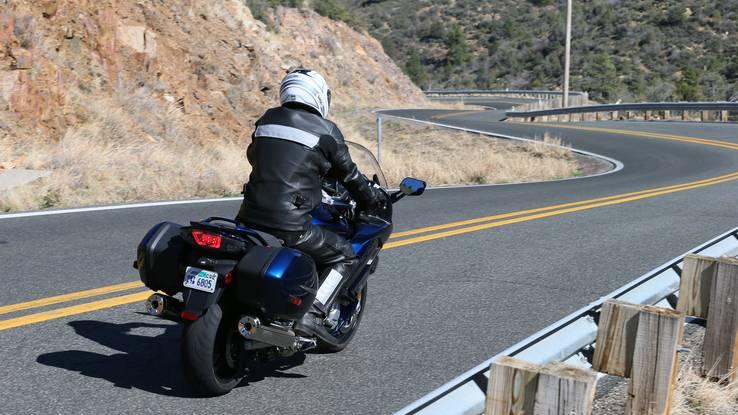Putting more sport in sport touring
The new 2016 Yamaha FJR1300 aims to offer the perfect balance of sporty performance and cruising comfort.
The vast majority of the motorcycles sold in the U.S. are what you call “cruisers”: stylish, comfortable V-twins made for ease of travel and looking good getting there. Let’s just call them “Harleys.” On the other end of the spectrum are your sport bikes: fast, lightweight, quick-cornering racers made for performance. Think of every Ducati ever made. But in between is a category that combines a little of both — the Touring class. You could slice it even thinner and that’s where you’d get the “Sport Touring” class, making up 7,600 units of the nearly half a million motorcycle sales per year in the U.S. This is where you’ll find the 2016 Yamaha FJR1300, which Yamaha brazenly calls Supersport Touring. There are as many as 19 bikes you could put in this class, but Yamaha considers the Kawasaki Concours 14 and BMW R1200RT the closest competitors.
Like the others, the FJR straddles the divergent worlds of smooth cruising and grippy cornering. The model first came out in 2003 with the idea that you could ride it all day over great distances but didn’t necessarily have to get off, park it and take a public bus if you came upon a curve. It has had incremental improvements in the 13 years since: ABS a year after it debuted, all-new bodywork in ’06 and again in 2013, and numerous electronic upgrades for everything from engine response to suspension adjustments.
“This year our objectives were to improve comfort,” said Derek Brooks, R&D and product planning manager at Yamaha.
Toward that end, the FJR sports a laundry list of comfort features, some old, a few new. You can adjust the windscreen height electrically with a switch on the handlebar, you can adjust the handlebars themselves with a few tools, and you can raise or lower the seat height from 31.7 inches to 32.5 with no tools at all, but you have to stop and get off to do it. The new headlights and turn signals are all LEDs and there are three sequentially lit turning lights that use input from the bike’s inertial measuring unit to click on one at a time as you lean into turns. The heated grips have 10 settings. And there’s a simple cruise control switch that’s as easy to operate as the one on your car.
The base FJR1300A uses conventional front forks from KYB this year to replace last year’s Yamaha-designed forks. In back there is a big lever under the seat to set rear spring preload to hard or soft. Nice and simple. The upscale 1300ES offers electronically adjustable front and rear suspensions with four preload settings. On top of that there are three damping adjustments which you can do on the fly and an additional seven fine-tuning damping settings that you must be stopped to adjust.
The electronically controlled throttle allows not only that cruise control but two basic modes of throttle mapping via Yamaha’s D-mode. When you put it in gear and start to let out the clutch it automatically increases rpm by 200 to “give you a little bit more confidence,” according to Brooks. Sport mode gives a sharper throttle response while Touring mode is softer. The settings don’t affect total power output, just response.
The engine stays the same for 2016, a 1,298cc fuel-injected transverse-mounted inline four sitting in a Deltabox frame. In response to customer (and press) feedback Yamaha added another gear to the former five-speed gearbox but did it without having to change the size of the transmission case. The new gears have helical cross sections instead of last year’s straight-cut for smoother engagement. From there the 102 lb-ft of torque (Yamaha doesn’t release horsepower) are sent to the rear wheel via shaft drive.
There are two brake discs in front and one in back but if you step on just the rear brake pedal one of the front discs engages, too. And, of course, the front brakes have ABS on the ES model.

Prices start at $ 16,390.
What’s It Like To Ride?
Set it up from its kickstand and you immediately notice the extra curb weight of a touring bike. In this case it’s 635 pounds with all the fluids, about 200 pounds more than a typical sport bike. The weight gives a kinetic solidity when underway but is always there when launching from a standstill or leaning into a corner to remind you that you are on a touring bike. Start it up and you’ll find that the inline four is among the smoothest and quietest engines of its size, so much so that if you depend on engine sound or vibration to help you shift and engage the clutch, you might need to heighten your senses.
Our first ride was on the upscale 1300ES, the one with 81 different settings. It took a few launches to get comfortable with the light and silent clutch engagement but we got the hang of it. The assist and slipper clutch features use the torque of the motor to bring the plates together for assist, which results in 20 percent lighter pull effort on the clutch. As you’re accelerating the engine is creating torque on the plates. On deceleration the engine is pushing the plates apart. The result is a nice smooth clutch.
Those 102 lb-ft of torque were appreciated right away. There was enough torque that we found ourselves using only the first few thousand rpms for most riding. At 75 mph on the highway the tach read right around 3,500 rpm; at 80 mph it was at about 4,000. That was in the new sixth gear, a gear we found ourselves in most of the day.
The day — two days, actually — started in Phoenix and wound 250 miles north to Sedona, via Payson and Jerome. Most of the route was on straight roads and almost every road was smooth as a billiard table. How does Arizona do it? Maybe the lack of freezing temps and warming spells help keep the pavement from breaking up. But with roads so smooth we never really got a chance to feel all those different suspension settings. On the second day, as we wound back through the mountain town of Jerome (worth the ride to get to), we finally got a chance to speed through some nice curves. Here you will really appreciate the Touring or Supersport Touring class of bike. While cruiser bikes always seem to catch a foot peg or something when you lean into a turn, this class of bike lets you lean way over into a corner without a hiccup. We had a great time dive-bombing corner after corner all the way from Cottonwood to Prescott Valley (go early in the morning to avoid traffic). It was a blast in any of the settings.

Do I Want It?
If we were choosing between a cruiser and a touring bike, we’d get the touring bike every time. Especially if we were allowed only one bike. While a cruiser is great for, uh, cruising, a touring bike broadens your riding horizons without really exacting a price for it in comfort. It’s more fun to ride. The one thing we’d change on the FJR1300 in either trim level is the seat. Like the seat on the FZ-09, it was good for about 60 or 70 miles then started to feel distinctly like a wooden plank. Maybe it’s our keister, who knows? Yamaha has an optional soft seat, but we never tried it out. And there’s always Corbin and any number of aftermarket saddle makers happy to sell you something.
If choosing between the 1300A and 1300ES we’d get the A and save $ 1,600. The A stickers at $ 16,390 and the ES at $ 17,990. If choosing between the Yamaha and the competition, well, the Kawasaki is very fast and the BMW is rock-solid stable and also pretty fast. .. Better to ride each one and then decide. Or wait a year or so until Yamaha continues with the bike’s incremental improvements and incorporates the Inertial Measuring Unit in the ABS and traction control so you can really scrape a knee. Right now the IMU is used only for those nifty turning lights.
But do get something. Spring is officially here and if you listen closely — go ahead, listen — you can hear the road calling your name.




























